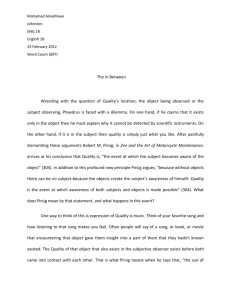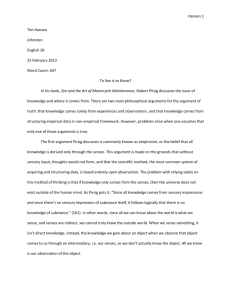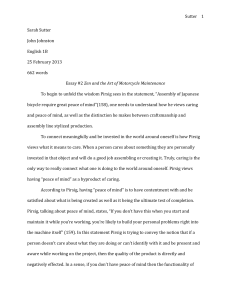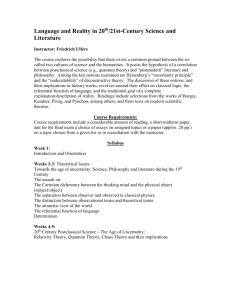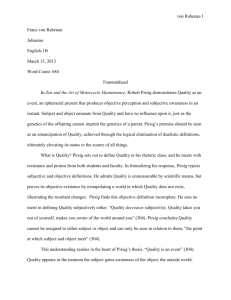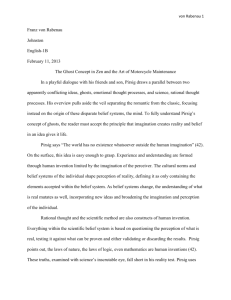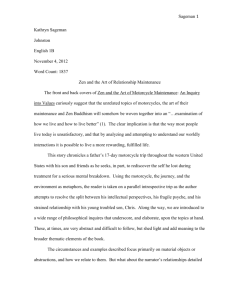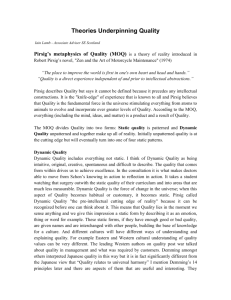binary arbitrarily
advertisement
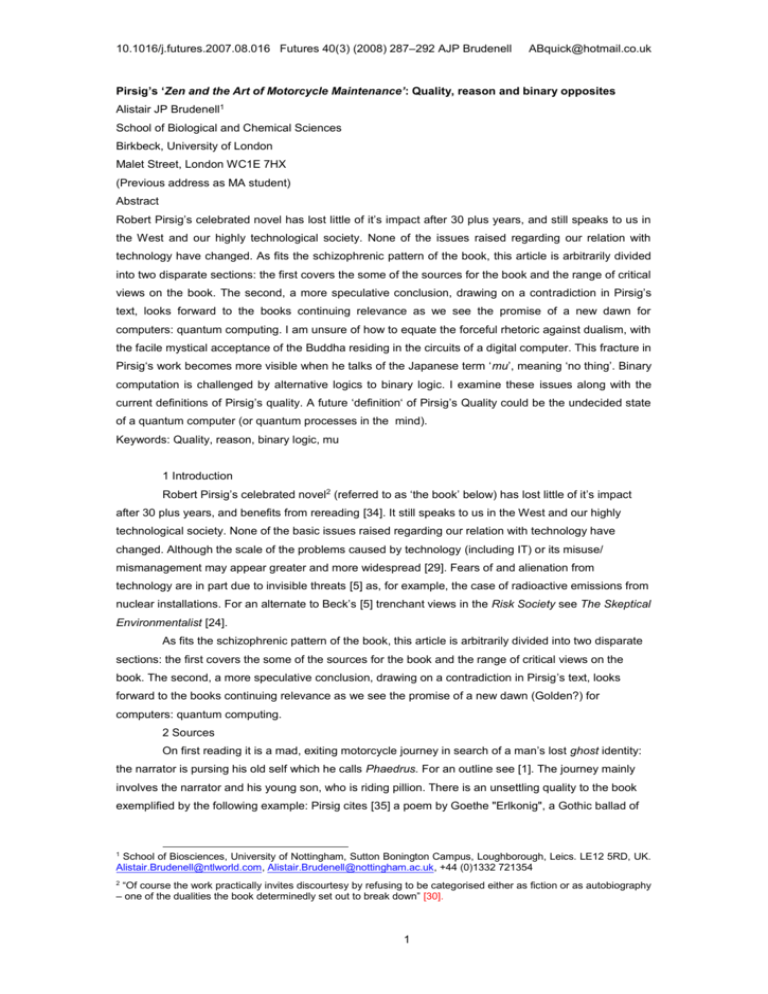
10.1016/j.futures.2007.08.016 Futures 40(3) (2008) 287–292 AJP Brudenell ABquick@hotmail.co.uk Pirsig’s ‘Zen and the Art of Motorcycle Maintenance’: Quality, reason and binary opposites Alistair JP Brudenell1 School of Biological and Chemical Sciences Birkbeck, University of London Malet Street, London WC1E 7HX (Previous address as MA student) Abstract Robert Pirsig’s celebrated novel has lost little of it’s impact after 30 plus years, and still speaks to us in the West and our highly technological society. None of the issues raised regarding our relation with technology have changed. As fits the schizophrenic pattern of the book, this article is arbitrarily divided into two disparate sections: the first covers the some of the sources for the book and the range of critical views on the book. The second, a more speculative conclusion, drawing on a contradiction in Pirsig’s text, looks forward to the books continuing relevance as we see the promise of a new dawn for computers: quantum computing. I am unsure of how to equate the forceful rhetoric against dualism, with the facile mystical acceptance of the Buddha residing in the circuits of a digital computer. This fracture in Pirsig‘s work becomes more visible when he talks of the Japanese term ‘mu’, meaning ‘no thing’. Binary computation is challenged by alternative logics to binary logic. I examine these issues along with the current definitions of Pirsig’s quality. A future ‘definition‘ of Pirsig’s Quality could be the undecided state of a quantum computer (or quantum processes in the mind). Keywords: Quality, reason, binary logic, mu 1 Introduction Robert Pirsig’s celebrated novel2 (referred to as ‘the book’ below) has lost little of it’s impact after 30 plus years, and benefits from rereading [34]. It still speaks to us in the West and our highly technological society. None of the basic issues raised regarding our relation with technology have changed. Although the scale of the problems caused by technology (including IT) or its misuse/ mismanagement may appear greater and more widespread [29]. Fears of and alienation from technology are in part due to invisible threats [5] as, for example, the case of radioactive emissions from nuclear installations. For an alternate to Beck’s [5] trenchant views in the Risk Society see The Skeptical Environmentalist [24]. As fits the schizophrenic pattern of the book, this article is arbitrarily divided into two disparate sections: the first covers the some of the sources for the book and the range of critical views on the book. The second, a more speculative conclusion, drawing on a contradiction in Pirsig’s text, looks forward to the books continuing relevance as we see the promise of a new dawn (Golden?) for computers: quantum computing. 2 Sources On first reading it is a mad, exiting motorcycle journey in search of a man’s lost ghost identity: the narrator is pursing his old self which he calls Phaedrus. For an outline see [1]. The journey mainly involves the narrator and his young son, who is riding pillion. There is an unsettling quality to the book exemplified by the following example: Pirsig cites [35] a poem by Goethe "Erlkonig", a Gothic ballad of 1 School of Biosciences, University of Nottingham, Sutton Bonington Campus, Loughborough, Leics. LE12 5RD, UK. Alistair.Brudenell@ntlworld.com, Alistair.Brudenell@nottingham.ac.uk, +44 (0)1332 721354 “Of course the work practically invites discourtesy by refusing to be categorised either as fiction or as autobiography – one of the dualities the book determinedly set out to break down” [30]. 2 1 10.1016/j.futures.2007.08.016 Futures 40(3) (2008) 287–292 AJP Brudenell ABquick@hotmail.co.uk 1782: which involves a narrator, the child, the father, and the `alderking`, a goblinlike `king of the alder grove': "How does it (the poem) end?" "In Failure - death of the child. The Ghost wins" [27,p.60] "The retrieval of Phaedrus, the reintegration of the personality that had been purged, means that this book is at bottom an existential work of literature - But Chris's father overcomes with the help of his son, the electrically induced loss of being at the hands of psychiatric technology and persists in his pursuit of a truth which goes beyond the usual meaning of the term as the Greeks and their philosophical, scientific and technological heirs understand it. The personality which had first pursued Quality was loveable to Chris and the Erlkonig personality which had rejected the quest and participated instead in the attempted murder of Phaedrus was existentially inauthentic." [35, p.92] The narrative departs from Goethe’s poem as “it is not the Demonking who is threatening the child’s psyche, but his father” [23]; the Phaedrus figure and the Erlkonig personality were disunited parts of the same character, unified by the end of the book. It is of interest that Pirsig should draw on the structure of Goethe’s poem as a basis for his own work: “it offers a root metaphor which is worked over again and again, finally to be stood on its head by the happy ending of the book” [35]. Pirsig also has a (self-)acknowledged debt to Thoreu’s Walden [10], the one book the narrator carries with him. An idea of Pirsig’s sources [9] helps with regard his critics. 4 Criticism The book was met with hyperbolic critical acclaim [for a list of reviews see 13,p.338-40], which for the most part it has lived up to. Astute critics hold that the book has been fairly consistently misread [30]. “After George Steiner’s [36] extravagant praise in The New Yorker (“the narrative tact, the perfect economy of effect defy criticism”), there was a predictable critical backlash, mostly a lot of patronising remarks about Pirsig’s schoolboy solemnity and his potted summaries of the history of philosophy [quotation in 31]. Rodino [30] concludes that this kind of the blame is itself often based on naive critical assumptions, due to difficulty in distinguishing between the narrator and author of the book or a reluctance to admit any art or fiction in the work. There are a number of critical articles [see 1, 4, 10, good selection in 13, 23, 30, 33, 36], which are on the whole positive [e.g 12], a rare totally hostile exception being Hoffman; who complains of answers to pseudo-questions and “grandiose promises and undelivered goods” [20]. Some take Pirsig to task over issues such as the narrator’s difficulty with personal relationships [11], especially with regard that with his son Chris [1, 20, 30]. I would risk that the poverty of this relationship is less autobiographical than a rhetorical plot device to underscore the riven nature of the narrator and his ghost Phaedrus. In support of this view: ”Such ironic friction between the action and the commentary is precisely the principle strength of the book as well as the cause of much confusion over it” [30]; and “This (emotional) blindness is not a weakness … but is rather part of its overall plan” [33]. Pirsig’s use of a modified structure from Goethe’s "Erlkonig" confirms this view, confounding Pirsig’s more mealy mouthed moralising detractors [e.g. 20]. 5 Themes The narrative is interspersed with edifying Chautauquas3 and backtracking diatribes on Greek philosophy. The latter he delivers with a driven anger, venom and vigour that is slightly disconcerting at first. However it may just be a literary device to drive otherwise unwilling readers to read the philosophy sections. On later re-readings, I have skipped the non-philosophy sections, which does remove the rhetorical impact of the whole text. Pirsig also upsets Platonists, with his “partial, inadequate and obtuse” reading of Plato [19]. Pirsig’s motivation is the malaise of modern society, the alienation of self from technology, and thus from our technological society: "Phaedrus`s philosophical thesis is not merely an hypothetical construct around which to drape the narrative - on the contrary it informs every detail of the novel. His interest in philosophy is ethically motivated, stimulated by his growing conviction that the deplorable quality of life in Western Society 3 An old time series of popular talks from travelling tent shows [27, p.7] 2 10.1016/j.futures.2007.08.016 Futures 40(3) (2008) 287–292 AJP Brudenell ABquick@hotmail.co.uk is contingent upon its dualistic basis. Pessimism is an intelligible response to the intolerable schism between fact and value and the consequent tyranny of science. Reason has installed itself as absolute arbiter of truth, thereby trivialising all it does not accommodate: "Reason has become an inhuman, mechanical, lifeless and blind force, death force giving rise to science and technology that somehow make you a stranger in your own land”. It becomes Phaedrus`s passionate, fanatical desire to dispose of reason and close this breach. His strategy is not to retreat into subjectivity or irrationality, but to discover when and how reason first gained such power. For that will coincide with the inception of dualism - `the solution to the problem isn't that you abandon rationality, but that you expand the nature of rationality so it is capable of coming up with a solution`." [3, p.34-35] This reading of the text from Una Allis [3] is a strong re-statement of the central theme of the book. Pirsig is not against technology or science, but rather the dominance of blind Reason [for a ‘scholarly’ development of this theme see 14, 15]. This was against the prevailing mythos of the time. When he was teaching in the 1950’s the Universities could well be described as The Church of Reason [27, p144], maybe now in our post-modern view we can see remaining Citadels of Reason within our ‘Polyverstity’s or Multiversity’s’ (as compared with the old ‘unified’ University). I would hope for a wider Church of Ideas that could supplant the old Church of Reason and open up the citadels. Pirsig also considers the split between art and science: “The divorce of art from technology is completely unnatural…Rotisserie assembly is actually a long lost art of sculpture … [27,p.161]: drawing on this passage Weiland [37, p.304] concludes that; "artists and humanists have misunderstood technology by overstating its ethical implications, its destructive influence on work and values". Pirsig disagrees with his technophobic travelling companion John “about cycle maintenance; “not because I am out of sympathy with their feelings about technology. I just feel that their flight from and hatred of technology is self-defeating. The Buddha, the Godhead, resides quite comfortably in the circuits of a digital computer or the gears of a cycle transmission as he does at the top of a mountain or in the petals of a flower.” [27, p.18] I am unsure of how to equate the forceful rhetoric (see previous quotation from Una Allis above) against dualism, with the facile mystical acceptance of the Buddha residing in the circuits of a digital computer. See [34, p.215] for a critical discussion of the metaphor of Buddha in Pirisig. After all the digital binary code (0,1; yes and no; this or that, [27, p.313]) that forms the basis of the digital computer must be the most pervasive and almost invisible aspect of occidental dualistic thought in our technological and computer-driven lives. This fracture in Pirsig‘s work becomes more visible when he talks of the Japanese term ‘mu’, meaning ‘no thing’: “because we are unaccustomed to it we don’t usually see that there is a third possible logical term equal to yes and no which is capable of expanding our understanding in an unrecognised direction” [27, p.314]. "Only our cultural bias Pirsig claims makes us scorn `mu' as mysterious or esoteric and believe in the greater value of definite answers. And the need for `mu' answers suggest that even the metaphor of motorcycle maintenance is an incomplete metaphor for non-mechanical activities" [37 p.308]. Every scientist has found a mu answer to an experiment designed to give a yes/no answer. The mu answer is important: “It has told the scientist that the context of his question is too small for Nature’s answer…” [27, p.315] This may deflect Weiland’s criticism in the above quotation, which also disregards that metaphors are by definition always incomplete – otherwise they wouldn’t be metaphors; a metaphor may not be perfect, and still be useful. For an interesting insight into Zen Buddhism and the differences between Western and Japanese thinking especially with regard science see [25]. The basis of binary computation and classical Western Science is challenged by alternative logics to binary logic (X is either A or non-A): To understand the place of Western Science in the global picture we may have to consider the implications of the fourfold logics of Hindusim4.[32]. “The fourfold Hindu logic (with the extra forms: X is neither A nor non-A; nor both A and non-A; nor neither A nor non-A) is both a symbolic logic and a logic of cognition”.[32] 4 3 10.1016/j.futures.2007.08.016 Futures 40(3) (2008) 287–292 AJP Brudenell ABquick@hotmail.co.uk 6 Quality & Reason Pirsig tries to resolve his difficulties with dualism5 and the dominance of reason - the power of The Church of Reason - with a rhetoric of an undefinable (p.225) pre-rational quality as the source of all experience. This is the hardest part of the book to grasp and when he wrote it he sounded even madder than he would now [for meanings of Pirsig’s Quality see 11, 16]. Maybe one reason he went ‘insane’ was due to his difficulties here. The problem with value is that it resists logical definition, and no-one can give ‘necessary and sufficient’ conditions of value or Quality [12]. In order to understand Phraedrus’s position it was helpful to conduct a few breaching experiments on friends and colleagues: for example I now accept that the ‘Problem of Induction’ is not an issue, but an aid to understanding our human limitations and to avoid hubris. It is easy to reject neo-Darwinist random natural selection as the sole explanation for Evolution [21]. More difficult is the rejection of binary logic as a complete and sound basis for thought and action. This is difficult, as it appears to be ‘hard-wired’ into our Western conditioning and is thus is often used unquestioningly. What possible benefit can be made from questioning binary logic? After all it is the basis for the whole of rational Western thought and supports much of science & technology. An uncritical acceptance of binary logic may lead to Scientism. I am more concerned with the psychological effect of accepting binary logic/simple dualities, rather than denying any effectiveness in necessarily limited well-defined systems. This is exemplified by the dualities such as ‘Subject/Object’ or ‘Nature/Society’ – it is of note that echoes of Pirsig are too be found in Bruno Latour’s trajectories of actant stabilisation gradients and actor-network theory [22]. Although no explicit mention of Pirsig is made, these alternatives to simple dualities are exercises in his spirit – and may enable a new understanding of his sometimes mystical Quality. “In the world of affairs (and particularly in the sciences that serve it) quality is a surrogate for certainty” [16, p.792]. Quality must be reduced to numbers if is to be respected [17]. The potential dystopic consequences of this derogation of Quality are examined in [29]. The ‘Positivistic’ definiteness and seeming exactness required for the use of binary logic may be in part responsible for the genocide and excesses of this and the last century. Fascistic and racist thinking are derived from the absolutist ‘all Jews (Immigrants, etc.) are …’ type thinking. See [26] for further discussion. That ordinary citizens participate in massacres and genocide is well documented [8]. Thus the way ordinary citizens are conditioned and taught to think and act is of vital importance if we are to have a tolerant and civilised society. That these are results of the logic, not the use of digital computer hardware, is demonstrated by the Nazi’s selection procedure for concentration camp victims which used the precursor of the computer: IBM’s punch cards and sorting system [6, p.11]. 7 Binary logic It does not follow that just because our digital computers are so primitive to have to use binary logic that our brains are digital.6 Human brains appear to act more like Artificial Neural Networks,7 these 5 Further consideration of the use of the analytic knife Phaedrus wielded so deftly [7], producing such tidy dualisms, is that ironically Quality itself has been divided by Pirsig himself [28] into structural and dynamical quality [see discussion in 2, p.479]. Furthermore the more mystical aspects of Pirsig’s quality are avoided [16]. 6 it has been claimed that our DNA and even our brains are binary but..."The language of DNA is digital, but not binary. Where binary encoding has 0 and 1 to work with (2 - hence the 'bi'nary), DNA has 4 positions, T, C, G and A. Whereas a digital byte is mostly 8 binary digits, a DNA 'byte' (called a 'codon') has three digits. Because each digit can have 4 values instead of 2, a DNA codon has 64 possible values, compared to a binary byte which has 256. http://ds9a.nl/amazing-dna/ “Neural networks take a different approach to problem solving than that of conventional computers. Conventional computers use an algorithmic approach i.e. the computer follows a set of instructions in order to solve a problem. Unless the specific steps that the computer needs to follow are known the computer cannot solve the problem. That restricts the problem solving capability of conventional computers to problems that we already understand and know 7 4 10.1016/j.futures.2007.08.016 Futures 40(3) (2008) 287–292 AJP Brudenell ABquick@hotmail.co.uk functioning as analogue circuits. With the, at present long-off, advent of Quantum computing8 we will no doubt believe that human brains are miniature mirrors of the cosmos; with events and thoughts being determined by stochastic quantum sub-atomic processes [see 18]. This may well become a more dominant metaphor, but will the eventual dominance of quantum computers mean that we will begin to think differently after exposure to this distant possibility? A future ‘definition‘ of Pirsig’s Quality could be the undecided state of a quantum computer (or possibly quantum processes in the human mind). On the 60th Anniversary of ‘Zen and Art of Motorcycle Maintenance’ maybe Pirsig’s vision will finally come to full fruition. References: 1. Adams, R.M. (1974) Good Trip. New York Review of Books, 1974. 11(10): p. 22-23. (In: Guidebook to Zen and the art of motorcycle maintenance/ Ronald L. DiSanto and Thomas J. Steele, pp. 240-245). 2. Allen, T.F.H., J.A. Tainter, J.C. Pires, and T.W. Hoekstra (2001) Dragnet ecology - "Just the facts, ma'am": The privilege of science in a postmodern world. Bioscience, 2001. 51(6): p. 475-485. 3. Allis, U. (1978) 'Zen and the Art of Motorcycle Maintenance'. Critical Quarterly (Manchester), 1978. 20(3): p. 33-41. (Also in: Guidebook to Zen and the art of motorcycle maintenance/ Ronald L. DiSanto and Thomas J. Steele, pp. 260-270). 4. Basalla, G. (1975) Man and Machine. Science, 1975. 187: p. 248-250. (In: Guidebook to Zen and the art of motorcycle maintenance/ Ronald L. DiSanto and Thomas J. Steele, pp. 255-259). 5. Beck, U. (1992) Risk Society: Towards a New Modernity, London: Sage Publications. 306 pp. 6. Black, E. (2002) IBM and the Holocaust: Time Warner Paperbacks. 710 pp. 7. Bump, J. (1983) Creativity, Rationality, and Metaphor in Pirsig,Robert 'Zen and the Art of Motorcycle Maintenance'. South Atlantic Quarterly, 1983. 82(4): p. 370-380 (In: Guidebook to Zen and the art of motorcycle maintenance/ Ronald L. DiSanto and Thomas J. Steele, pp. 316-328). 8. Burleigh, M. (2001) The Third Reich: A new history: Pan Macmillan, London. 965 pp. 9. Carter, N.C. (1978) 1970 Images of the Machine abd the Garden: Kosinski, Crews and Pirsig. Soundings: An Interdisiplinary Journal (Nashville, TN, Vanderbilt University), 1978. 61: p. 105122. 10. Cawelti, J.G. (1979) Ringer to Sheehy to Pirsig: The 'Greening' of American Ideals of Success. Journal of American Culture, 1979. 2: p. 147-161. (In: Guidebook to Zen and the art of motorcycle maintenance/ Ronald L. DiSanto and Thomas J. Steele, pp. 271-281). 11. Chaney, N. (1981) Pirsig's Piety for The Age of Aquarius. Renascence, 1981. 33(3): p. 162-171. (PCI Fulltext: http://pcift.chadwyck.co.uk/). 12. Crusius, T. (1976) In praise of Pirsig's 'Zen and the Art of Motorcycle Maintenance'. Western Speech: journal of the Western Speech. Communication Association (Portland State Univ., OR), 1976. 40: p. 168-77. 13. DiSanto, R.L. and T.J. Steele (1990) Guidebook to Zen and the art of motorcycle maintenance. 1st ed: New York : W. Morrow. 407 pp. how to solve. But computers would be so much more useful if they could do things that we don't exactly know how to do.” http://www.doc.ic.ac.uk/~nd/surprise_96/journal/vol4/cs11/report.html 8 "In a quantum computer, the fundamental unit of information (called a quantum bit or qubit), is not binary but rather more quaternary in nature. This qubit property arises as a direct consequence of its adherence to the laws of quantum mechanics which differ radically from the laws of classical physics. A qubit can exist not only in a state corresponding to the logical state 0 or 1 as in a classical bit, but also in states corresponding to a blend or superposition of these classical states. In other words, a qubit can exist as a zero, a one, or simultaneously as both 0 and 1, with a numerical coefficient representing the probability for each state." http://www.cs.caltech.edu/~westside/quantum-intro.html 5 10.1016/j.futures.2007.08.016 Futures 40(3) (2008) 287–292 AJP Brudenell ABquick@hotmail.co.uk 14. Feyerabend, P. (1975) Against Method: outline of an anarchistic theory of knowledge, London: Verso. 279 pp. 15. Feyerabend, P. (1987) Farewell to Reason, London: Verso. 327 pp. 16. Funtowicz, S.O. and J.R. Ravetz (1997) The poetry of thermodynamics - Energy, entropy/exergy and quality. Futures, 1997. 29(9): p. 791-810. (http://www.sciencedirect.com/science/journal/00163287). 17. Funtowitz, S.O. and J.R. Ravetz (1990) Uncertainty and Quality in Science for Policy: Kluwer, Dordrecht. (Cited by Funtowitz & Ravetz 1997). 18. Hameroff, S.R. (1998) 'Funda-mentality': Is the conscious mind subtly linked to a basic level of the universe? Trends in Cognitive Sciences, 1998. 2(4): p. 119-124. 19. Harpham, G.G. (1988) Rhetoric and the Madness of Philosophy in Plato and Pirsig. Contemporary Literature, 1988. 29(1): p. 64-81. 20. Hoffman, E. (1974) Zen and the Art of Motorcycle Maintenance, by Robert Pirsig (Book Review). Commentary, 1974. 58(4): p. 87-91. (PCI Fulltext: http://pcift.chadwyck.co.uk/). 21. Kauffman, S. (1995) At Home in the Universe, London.: Penguin. 22. Latour, B. (1999) Ch 19: One more turn after the social turn... Routledge, London & New York. 276289. 23. Lhamon, W.T., Jr. (1974) A Fine Fiction. New Republic, 1974. 170(June 29): p. 24-26. (In: Guidebook to Zen and the art of motorcycle maintenance/ Ronald L. DiSanto and Thomas J. Steele, pp. 246-249). 24. Lomborg, B. (2001) The Skeptical Environmentalist: Measuring the real state of the world, Cambridge: CUP. 515. 25. Motokawa, T. (1989) Sushi Science and Hamburger Science. Perspectives in Biology and Medicine, 1989. 32(4): p. 489-504. 26. Nandy, A. (1983) The Pathology of Objectivity. Ecologist, 1983. 13(6): p. 202-207. 27. Pirsig, R.M. (1989) Zen and the Art of Motorcycle Maintenance: Transworld, London (Originaly published by Bodley Head in 1974). 406 pp. 28. Pirsig, R.M. (1991) Lila: An Inquiry into Morals: Bantam Press, London. 418 pp. 29. Ravetz, J. (2000) Fault-lines of globalised civilisation. Futures, 2000. 32(1): p. 27-42. (http://www.sciencedirect.com/science/journal/00163287). 30. Rodino, R.H. (1981) Irony and earnestness in Robert Pirsig's 'Zen and the Art of Motorcycle Maintenance'. Critique: studies in modern fiction (Georgia Inst. of Technology, Atlanta), 1981. 22(1): p. 21-31. (In: Guidebook to Zen and the art of motorcycle maintenance/ Ronald L. DiSanto and Thomas J. Steele, pp. 293-303). 31. Rodino, R.H. (1981) The Matrix of Journeys in 'Zen and the Art of Motorcycle Maintenance'. Journal of Narrative Technique, 1981. 11(1): p. 53-63 (In: Guidebook to Zen and the art of motorcycle maintenance/ Ronald L. DiSanto and Thomas J. Steele, pp. 304-315). 32. Sardar, Z. (2000) Thomas Kuhn and the Science Wars. Postmodern Encounters, ed. R. Appignanesi, Cambridge: Icon Books. 76. 33. Shearon, F.B. (1983) Visual Imagery and Internal Awareness in Pirsig's ZMM. Kentucky Philological Association Bulletin: Best Papers, 1983: p. 53-62. (In: Guidebook to Zen and the art of motorcycle maintenance/ Ronald L. DiSanto and Thomas J. Steele, pp. 329-338). 34. Singer, B. (1981) Reflections on Robert Pirsig. Durham University Journal, 1981. 73(2): p. 213-219. 35. Steele, T.S. (1979) 'Zen and the Art of Motorcycle Maintenance': the identity of the Erlkönig. Ariel: a review of international English literature (Univ. of Calgary, Alta), 1979. 10(1): p. 83-93. (Also In: 6 10.1016/j.futures.2007.08.016 Futures 40(3) (2008) 287–292 AJP Brudenell ABquick@hotmail.co.uk Guidebook to Zen and the art of motorcycle maintenance/ Ronald L. DiSanto and Thomas J. Steele, pp. 282-292). 36. Steiner, G. (1974) Uneasy Rider. New Yorker, 1974. 50(8): p. 147-150. (In: Guidebook to Zen and the art of motorcycle maintenance/ Ronald L. DiSanto and Thomas J. Steele, pp. 250-254). 37. Weiland, S. (1980) The humanities and the art of motorcycle maintenance. Southern Humanities Review (Auburn Univ., AL), 1980. 14: p. 301-9. 7
